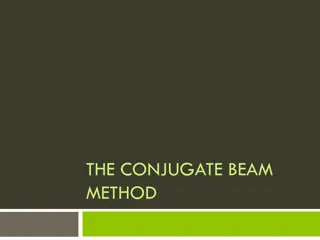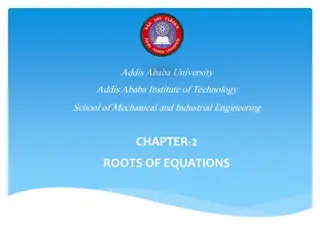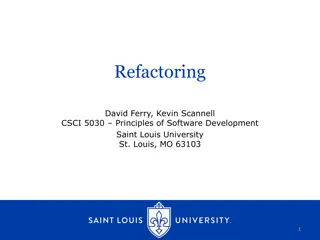Identifying Extract Class and Extract Method Refactoring Opportunities
The dissertation discusses identifying extract class and extract method refactoring opportunities through the analysis of variable declarations and uses. It covers the impact of maintenance phases on software quality and cost, software quality aspects, bad smells in code, and software refactoring principles. Steps to refactoring are outlined, emphasizing the importance of code selection and addressing common errors in the process.
Download Presentation

Please find below an Image/Link to download the presentation.
The content on the website is provided AS IS for your information and personal use only. It may not be sold, licensed, or shared on other websites without obtaining consent from the author.If you encounter any issues during the download, it is possible that the publisher has removed the file from their server.
You are allowed to download the files provided on this website for personal or commercial use, subject to the condition that they are used lawfully. All files are the property of their respective owners.
The content on the website is provided AS IS for your information and personal use only. It may not be sold, licensed, or shared on other websites without obtaining consent from the author.
E N D
Presentation Transcript
Identifying Extract Class and Extract Method Refactoring Opportunities Through Analysis of Variable Declarations and Uses Mehmet Kaya PhD Dissertation 5/30/2014 1
Outline Introduction and Problem Presentation Overview of contributions Cohesion and Refactoring Extract Method - Placement Tree Extract Method - Hammock Graph Conclusion and Future Work 2
Maintenance Phase Changes usually degrade quality of software. Supports the software product from its inception to its retirement and ends with product s retirement [50] Lasts for 10 to 20 years [3] Increases the cost of production dramatically Maintenance effort = 2|3 x Creating new software [2] Comprising 60-75% of the overall cost [3, 72, 51] 3
Software Quality vs. Cost Developing a large system requires a team. Each component will be read and used by other developers. Software may be modified/maintained by developers who are not original authors. Some quality aspects: Cohesion Comprehensibility/ Cyclomatic Complexity Readability Reusability 4
Quality vs. Bad Smells in Code Duplicated Code identical or very similar code exists in more than one location Long Method method that has grown too large Large Class class that has grown too large Long Parameter List hard to understand/read Feature Envy a class that uses methods of another class excessively 5
Software Refactoring Refactoring is defined by Fowler et al. as "the exact reverse of the normal notion of software decay" [5] Example: Renaming an attribute Extraction of new units Goal: to make the software easier to understand and modify. Result: better understandable/readable/reusable code or reduced cost of maintenance/production 6
Steps to Refactoring 1. Selection of Code Fragments Error messages (Eclipse) [58] Selected block references a local type declared outside the selection: A local type declaration is not part of the selection but is referenced by one of the statements selected for extraction. A local type declared in the selected block is referenced outside the selection: The selection covers a local type declaration but the type is also referenced outside the selected statements. Error messages are non-specific and unhelpful in diagnosing problems [73] Discouraging programmers from refactoring at all [73] a) Read the software code to get familiar b) Inspect the code to find code regions 2. Extraction of Code Fragments a) Determine the feasibility of refactoring b) Perform Refactoring / Create method replace with method call Manual! Eclipse, Visual Studio, Resharper, Refactor Pro 7
Identifying Refactoring Opportunities Refactoring is based on human intuition [5] Although Fowler introduces many different kinds of refactoring, the identification of location where to apply these re-factorings is ambiguous [5] Developer is the last authority to decide where to apply the refactoring [46] Although refactoring is practiced very frequently, 90 percent of refactoring is applied manually and refactoring tools need further improvements [64,65] 10
Goal of Our Research Refactoring is acknowledged to be a subjective ambiguous process Our contribution turns that into an objective quantitative process Find techniques for suggesting refactoring Implement the techniques in tools Produce result that can be represented visually No need to inspect code to detect refactoring Developer is still the last authority 11
Overview of Contribution 1 Large Class Code Defect Fowler suggests based on number of data member [5] Simple and cohesive, understandable, and readable Cohesion is simply the degree to which the elements of a module belong together Higher quality=better reuse and maintainability Should capture one and only one key abstraction [78] Remedy: Extract Class Refactoring Extract each distinct task as a separate unit 12
Some Results of Contribution 1 Extract Class Refactoring Before and After # of Methods # of Data Members # of Lines Original Class 13 9 150 Class After Refactoring 13 3 72 Extracted Class 1 6 2 49 Extracted Class 2 12 3 105 Extracted Class 3 5 4 35 13
Overview of Contribution 2 Long Method Code Defect The source of many other code defects [1] Smaller methods are easier to read, comprehend, and maintain [1] Is this a subjective measure? Should be shorter with one clear intention Remedy: Extract Method Refactoring Extract appropriate code fragments as separate methods 14
Some Results of Contribution 2 Extract Method with Placement Tree Before and After Method: W_Calculate Domain: Medical # of Extraction: 9 LOC Before Refactoring 379 After Refactoring 39 Extracted Method 1 13 Extracted Method 2 13 Extracted Method 3 13 Extracted Method 4 13 Extracted Method 5 19 Extracted Method 6 33 Extracted Method 7 16 Extracted Method 8 45 Extracted Method 9 62 Cyclomatic Complexity 46 4 3 3 3 3 Method: doAction Domain: Analyzer # of Extraction: 3 LOC Before Refactoring 101 After Refactoring 21 Extracted Method 1 52 Extracted Method 2 20 Extracted Method 3 21 Cyclomatic Complexity 44 3 27 11 6 5 9 5 9 11 15
Overview of Contribution 3 Long Parameter List Code Defect Impact the quality of software programs dramatically Difficult to understand and test [5] Maintenance phase requires more time and effort Extract Method may result in long parameter lists We do not identify existing long parameter lists. Provide an opportunity to observe extract method refactoring opportunities based on the desired length of parameter list 16
Some Results of Contribution 3 Method: run_dlgProc Domain: Notepad++ # of Extraction: 25 LOC Before Refactoring 560 After Refactoring 269 Extracted Method 1 19 Extracted Method 2 9 Extracted Method 3 13 Extracted Method 4 28 Extracted Method 5 5 Extracted Method 6 6 Extracted Method 7 8 Extracted Method 8 6 Extracted Method 9 6 Extracted Method 10 15 Extracted Method 11 6 Extracted Method 12 14 Extracted Method 13 7 Extracted Method 14 7 Extracted Method 15 7 Extracted Method 16 6 Extracted Method 17 5 Extracted Method 18 8 Extracted Method 19 4 Extracted Method 20 5 Extracted Method 21 20 Extracted Method 22 21 Extracted Method 23 19 Extracted Method 24 17 Extracted Method 25 17 Cyclomatic Complexity 54 35 1 2 3 5 1 1 1 1 1 2 1 2 1 1 1 1 1 2 1 1 3 4 3 2 3 # of Parameters 3 3 0 0 0 0 0 0 0 0 0 0 0 0 0 0 0 0 0 0 0 0 1 1 1 1 2 Extract Method with Hammock Before and After 17
Tools and Techniques Rule Based Parser (Dr Fawcett) Developed a rule based ad-hoc parser Analyzes source code to extract information Results we seek depend on only a small part of the language grammar Simple design and very flexible to extend Designed on an Actions and Rules based approach 18
Tools and Techniques (cont'd.) Program Slicing The method of automatically decomposing programs by analyzing their relationships between statements based on data and control flow [9] Slicing criterion: C= (9, sum). 1 2 3 4 5 6 7 8 9 10 int i; int sum = 0; int product = 1; for(i = 0; i < N; ++i) { sum = sum + i; product = product *i; } cout<< sum; cout<< product; int i; int sum = 0; for(i = 0; i < N; ++i) { sum = sum + i; } cout<< sum; 20
Tools and Techniques (cont'd.) Graph Theory - Hammock Graphs Definition: Let G be a control flow graph for program P. A hammock H is an induced sub-graph of G with a distinguished node V in H called the entry node and a distinguished node W not in H called the exit node such that All edges from (G - H) to H go to V. All edges from H to (G - H) go to W. 1. 2. 22
Tools and Techniques (cont'd.) Tools we developed - Analysis Brace Insertion: detects scopes, inserts missing braces, indents statements: enhanced readability and easier analysis Tree Generator: for each scope detects; source code, line numbers, variable references and produces an XML representation Hammock Graph Constructor: detects variable spans for each local variable, control blocks and interactions and produces an XML representation 25
Tools and Techniques (cont'd.) Tools we developed Visualization Each box is a scope this code is complex 26
Contribution 1: Class Cohesion and Refactoring Started to explore refactoring through variable declaration and uses Published in conference proceedings Goal: to quantitatively measure the cohesiveness of a class Should be able to help with suggesting refactoring Contribution 2 Contribution 3 37 Computer Software and Applications Conference Proceedings
Page 36 of Dissertation Construction of Slices Slicing Criteria Existing approaches require user-selected criteria Slicing Criteria defined as: DMC is the union of all private data members defined in class C. STdxC is the set of all program statements using data member d in C where d DMC. 38
Relationships Between Statements Line# Original Program Program Slicing Result Our Result 1 2 3 4 5 6 7 8 9 10 int i; int sum = 0; int product = 1; for(i = 0; i < N; ++i) { sum = sum + i; product = product *i; } cout<< sum; cout<< product; int i; int sum = 0; int i; int sum = 0; int product = 1; for(i = 0; i < N; ++i) { sum = sum + i; product = product *i; } cout<< sum; cout<< product; for(i = 0; i < N; ++i) { sum = sum + i; } cout<< sum; Relationships Relationships 39
Page 41 of Dissertation Determination of Our Slices SLstxC is the set of all program statements which are related to the statement st based on the conditions SLdxC is the union of all SLstxC where st STdxC and d DMC. SLdxC= 44
Data Slice Graph We generate a Data-Slice-Graph (DSG) to evaluate cohesiveness of the class It provides information for evaluating cohesion and suggesting refactoring Each node represents a data member of the class Edges are due to the relationship between slices 45
Data Slice Graph DSG= (V, E) is a undirected graph such that V is the finite set of data members representing vertices in the graph and E is the finite set of relationships between data members representing edges in the graph. |V| is the number of data members of the class v1v2 E iff SLv1xC SLv2xC 46
Cohesion Metric Quantitative and Constructive It is defined as the number of connected components, NC in its DSG The bigger NC, less cohesive our class is Each connected component in DSG refers to one abstraction 47
Possible Cohesion Values NC = 0 means class does not have any data members. NC = 1 occurs when the class has only one abstraction NC > 1 occurs when the class has more than one abstraction. 48
Suggesting Extract Class Refactoring C1 and C2 represent two different abstractions C1 = v1-v5 with slices C2= v6-v8 with their slices Each consecutive set of statements in the slice of any data member constructs a method v2 v6 v1 v7 C2 C1 v3 v4 v8 v5 49
Resultant DSG y1 top rawtime funinvokes stk x2 x1 topInvok y2 53
Example 2 NC=1 pIn prevChar prevprevChar EndQuoteCounter Currchar nextChar scTok Putbacks aSingleQuote NumLines _mode braceCount _state doReturnComments aCppComment doRSQAT 56
Summary of Contribution 1 We have proposed a new cohesion metric and an extract class refactoring Uses a technique similar to slicing Slicing Criteria defined based on variable references It is at the statement level Unlike Clustering, does not suggest moving attributes between classes We do not change the interface of the class Cannot measure for classes with no data members. 57
Contribution 2: Identification of Extract Method Refactoring using Placement Trees We try to build comprehensible, readable, and simple code The refactored methods are optimal and extend the lifetime of programs [4,5] Extract Method refactoring consists of two major activities: identification and extraction The goal is to create methods with focus on a single task Contribution 1 Contribution 3 58 SEKE Software Engineering and Knowledge Engineering Conf Proceedings
Placement Trees Placement of scopes in a method 59
Placement Tree Contains variable reference counts for individual scopes: 60
Dominant Variables Let V(F)={ v1, v2, .., vn } represent the set of all variable names 61
Dominant Variables Heuristic: Variable with highest reference count is the dominant variable Let D(B) represent the dominant variables in scope B, 62
Refactoring Suggestion Large code fragments with a color different from parent's color. 2. Consecutive sibling nodes with the same color. 1. 67
Experiments Analyzer Our Tool 72
Experiments Medical Imaging Research Code -> from 400 to 40 73
Experiments Medical Imaging Research Code -> 4000 Notepad++ - > 800 74
Summary of Contribution 2 Main focus is on identification of code fragments Introduced techniques and tools based on placement trees and variable reference counts Works effectively in real software systems Current heuristic works well, future improvements are planned Visual representation helps user observe refactoring suggestion easily Do not consider goto statements! May result in long parameter lists! 75
Contribution 3 Refactoring using Hammock Graphs This contribution focuses on managing the number of arguments in an extracted method s parameter list In contribution 2, length of parameter lists is omitted A long parameter list increases the complexity of a method and makes it difficult to maintain and to comprehend Contribution 1 Contribution 2 Under Review: IEEE Transactions on Software Engineering 76
Constructing of Hammocks Our technique proceeds in following steps: Generate the initial graph of variable declarations and references together with control blocks Convert all variable span into hammocks For each hammock, determine the number of variables referenced in the hammock 1. 2. 3. 4. Visualize the candidates based on a selected number of parameters dynamically 5. Observe refactoring opportunities, re-factor the code and continue if necessary 79
Page 86 of Dissertation Initial Graph G= (V, E) is a directed graph such that V is the set of program statements and E represents variable relationships L is the set of all local variables D(l) = statement where l is declared LR(l) = statement where last reference of l appears 80
Initial Graph Therefore: Furthermore, let the set C, line number S(c), and line number E(c) represent the set of all control statements in the given method, the line number where the Therefore: 81























